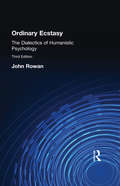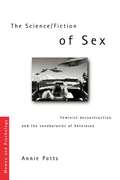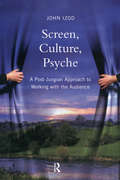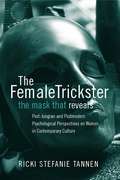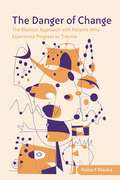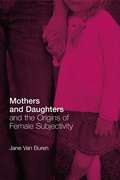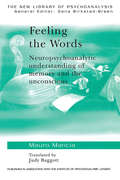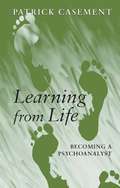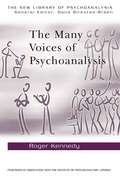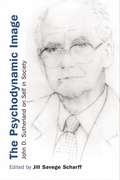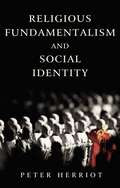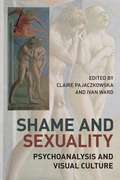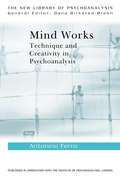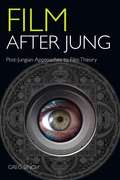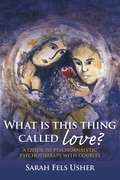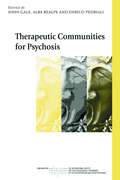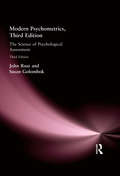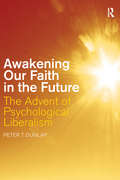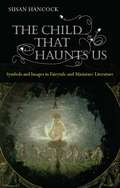- Table View
- List View
Ordinary Ecstasy: The Dialectics of Humanistic Psychology
by John RowanHumanistic Psychology ranges far and wide into education, management, gender issues and many other fields. Ordinary Ecstasy, first published in 1976, is widely regarded as one of the most important books on the subject. Although this new edition still contains much of the original material, it has been completely rethought in the light of postmodern ideas, with more emphasis on the paradoxes within humanistic psychology, and takes into account changes in many different areas, with a greatly extended bibliography.Ordinary Ecstasy is written not only for students and professionals involved in humanistic psychology - anyone who works with people in any way will find it valuable and interesting.
The Science/Fiction of Sex: Feminist Deconstruction and the Vocabularies of Heterosex (Women and Psychology)
by Annie PottsWhat can we learn from exploring the differences in male and female orgasmic experience? Is the penis an entity with a mind of its own? These issues and others, such as the popular portrayals of male sexuality as active and outwardly focused and female sexuality as passive and internally located, are discussed in The Science/Fiction of Sex. Contemporary feminist and poststructuralist theories of sex and gender are explored alongside an investigation of how people make sense of such concepts as heterosexuality, orgasm, sexual dysfunction, femininity and masculinity, and safer sex practice.Potts asks men and women about their actual experiences of heterosex. This interview material, combined with excerpts from sexological and medical texts and features from film and television, draws attention to the ways in which western cultural constructs influence our ideas and experiences of the body, sex, and gender. Potts also uses deconstructive theory as a textual tool, concentrating on how binary oppositions such as inside/outside and mind/body impact on our understandings of heterosex, and affect the power relations between women and men. She also examines how the radical postmodern theories of the body and sexuality proposed by Irigaray, Lyotard, and Deleuze and Guattari disrupt such dualistic modes of understanding and experiencing sexualized bodies. The Science/Fiction of Sex will be of interest to those studying women and psychology as well as gender studies, cultural studies, feminist studies, sociology, philosophy, public health and education.
Being in Love: Therapeutic Pathways Through Psychological Obstacles to Love
by Judith PickeringFinding true love is a journey of transformation obstructed by numerous psychological obstacles. Being in Love expands the traditional field of psychoanalytic couple therapy, and explores therapeutic methods of working through the obstacles leading to true love. Becoming who we are is an inherently relational journey: we uncover our truest nature and become most authentically real through the difficult and fearful, yet transformative intersubjective crucibles of our intimate relationships. In this book, Judith Pickering draws comparisons between Bion's concept of becoming in O, and being in love. She searches for pathways that lead away from relational confusion towards the discovery of genuine transformational relationships, and works towards finding better ways of relating to one another. This is achieved by encouraging couples to enjoy the actual presence, humanity, otherness and particularity of each other rather than expecting a partner to conform to our own expectations, projections, desires and presuppositions. Pickering draws on clinical material, contemporary psychoanalysis, cultural themes from the worlds of mythology and literature, and a wealth of therapeutic techniques in this fresh approach to couple therapy. Being in Love will therefore interest students and practitioners of psychoanalysis, psychology, and couple therapy, as well as all of those seeking to be more authentic in their relationships.
Screen, Culture, Psyche: A Post Jungian Approach to Working with the Audience
by John IzodScreen, Culture, Psyche illuminates recent developments in Jungian modes of media analysis, and illustrates how psychoanalytic theories have been adapted to allow for the interpretation of films and television programmes, employing Post-Jungian methods in the deep reading of a whole range of films. Readings of this kind can demonstrate the way that some films bear the psychological projections not only of their makers but of their audience, and assess the manner in which films engage the writer’s own psyche. Seeking to go beyond existing theories, John Izod explores the question of whether Jungian screen analysis can work for ordinary filmgoers - can what functions for the scholar be said to be true for people without a background in Jung’s ideas? Through detailed readings of a number of films and programmes, John Izod builds on the work previously done by Jungian film analysts, and moves on to contemplate the level of audience engagement. Offering deep readings of films directed by Kubrick and Bernardo Bertolucci, as well as satirical comedy, documentaries and twenty-first century Westerns, the book explores the extent to which they manage to make the psychological impact on spectators that films of a similar kind have done on Jungian writers. The author concludes that the screen texts with the best likelihood of impacting the culture of the audience through their collective psychological force fall at opposite ends of the size and budget range: highly personal documentaries, and the most affecting of mainstream genre movies. This innovative text will be essential reading for psychoanalysts and therapists, as well as students and scholars of film with an interest in understanding how screen products work psychologically to engage the viewer.
The Female Trickster: The Mask That Reveals, Post-Jungian and Postmodern Psychological Perspectives on Women in Contemporary Culture
by Ricki Stefanie TannenThe Female Trickster presents a Post-Jungian postmodern perspective regarding the role of women in contemporary Western society by investigating the re-emergence of female trickster energy in all aspects of popular culture. Ricki Tannen explores the psychological aspects of what happened when women’s imagination was legally and psychologically enclosed millennia ago and demonstrates how the re-emergence of Trickster energy through the female imagination has the radical potential to effect a transformation of western consciousness. Examples are drawn from a diverse range of sources, from Jane Austen, and female sleuth narratives, to Madonna and Sex and the City, illustrating how Trickster energy is used not to maintain power and control but to integrate and unite the paradoxical through humour. Subjects covered include: imagination and metaphor the traditional trickster law and the imagination humour: Eros using logos the postmodern female trickster. This highly original perspective on women's role in contemporary culture will offer readers a new vision of how humour psychologically operates as a healthy adaptation to trauma and adversity. It will be of great interest to all analytical psychologists and psychoanalysts as well as those in women's, cultural, legal and literary studies.
The Danger of Change: The Kleinian Approach with Patients Who Experience Progress as Trauma
by Robert WaskaConfusing clinical standoffs, loyalty to self-destruction and abrupt terminations are challenging and under-examined problems for the modern psychoanalytic practitioner. The Danger of Change is a timely book that addresses the so-called resistant patient so many clinicians are familiar with. Robert Waska blends theory based on Melanie Klein’s classical stance with the more contemporary Freudian/Kleinian school, to demonstrate how to understand patients that are resistant to progress. Divided into four sections, this book covers: reluctant patients and the fight against change: caught between the paranoid and depressive world greed and the dangers of change interruptions to the process of change: loss, envy, and the death instinct working toward change in the face of overwhelming odds Extensive and detailed clinical material is used to bring clarity to subjects including symbolism, conflict resolution, projective identification, the depressive and paranoid positions, change and trust. The Danger of Change brings hope and clarity to cases involving patients who experience progress as a threat to their emotional wellbeing. It will be of great interest to all practising psychoanalysts, as well as those studying psychoanalytic theory and practice.
Mothers and Daughters and the Origins of Female Subjectivity
by Jane Van BurenMothers and Daughters and the Origins of Female Subjectivity challenges the theory of the Oedipus complex, which permeates psychoanalytic theory, psychology, semiotics and cultural studies. The book focuses on the re-examination of women’s development through the theories of primitive mental states. Women’s subjectivity has been profoundly limited by continuing anxieties about the mother’s body. Jane Van Buren describes how women are gradually escaping the curse of inferiority and finding a voice, enabling the mother to provide their daughters with a legacy of rightful agency over their bodies and minds. Drawing on the theories of Klein, Bion and Winnicott, and incorporating recent developments in psychobiology, this book provides a novel approach to subjects including the dreams, myths and phantasies of individuals, the nature of mother and daughter relationships, sexuality, pregnancy, menstruation and the idea of the mother’s body as problematic and dangerous. This interdisciplinary investigation into curtailed female subjectivity and its many ramifications in society, culture and individual mental growth will be of great interest to all practising psychoanalysts, and those studying psychoanalytic theory and gender studies.
Feeling the Words: Neuropsychoanalytic Understanding of Memory and the Unconscious (The New Library of Psychoanalysis)
by Mauro ManciaHow are the implicit memory and the unrepressed unconscious related? Feeling the Words incorporates a thorough review of essential psychoanalytic concepts, a clear critical history of analytical ideas and an assessment of the contribution neuroscience has to offer. Mauro Mancia uses numerous detailed clinical examples to demonstrate how insights from neuroscience and infant development research can change how the analyst responds to his or her patient. Major topics such as the transference, the Oedipus complex, the interpretation of dreams and the nature of mental pain are reviewed and refined in the light of these recent developments. The book is divided into three parts, covering: Memory and the unconscious The dream: between neuroscience and psychoanalysis Further reflections on narcissism and other clinical topics Feeling the Words offers an original perspective on the connection between memory and the unconscious. It will be welcomed by all psychoanalysts interested in investigating new ways of working with patients.
Learning from Life: Becoming a Psychoanalyst
by Patrick CasementAll of life can be a resource for our learning. In his fourth and most personal book, Patrick Casement attempts to understand what he has learned from life, sharing a wide range of those experiences that have helped shape the analyst he has become. Patrick Casement shares various incidents in his life to demonstrate how these helped lay a foundation for his subsequent understanding of psychoanalysis. These examples from his life and work are powerful and at times very moving, but always filled with hope and compassion. This unique book gives a fascinating insight into fundamental questions concerning the acquisition of analytic wisdom and how personal experiences shape the analyst's approach to clinical work. It will be of great interest to all psychoanalysts and psychoanalytic psychotherapists.
The Many Voices of Psychoanalysis (The New Library of Psychoanalysis)
by Roger KennedyThe Many Voices of Psychoanalysis spans over thirty years of Roger Kennedy's work as a practicing psychoanalyst, providing a fascinating insight into the process of development of psychoanalytic identity. The introduction puts the papers into context, charting the development of the author’s practice and understanding of psychoanalysis and his position as part of the British Independent tradition. The intention of the chapters is to address the 'many voices' of psychoanalysis - the many roles and approaches a psychoanalyst may take, while adhering to the established ideas of psychoanalysis. The author takes into account the various influences which shape the psychoanalytic voice, drawing on literature, philosophy and sociology as well as analytic ideas. Subjects covered include: aspects of consciousness - one voice or many? handling the dual aspect of the transference bearing the unbearable - working with the abused mind the internal drama - psychoanalysis and the theatre a psychoanalyst in the family court. This book will be of use not only to practicing psychoanalysts, but also to psychoanalytic psychotherapists and other mental health workers. It will also appeal to anyone interested in the relationship between psychoanalysis and related disciplines.
The Psychodynamic Image: John D. Sutherland on Self in Society
by Jill Savege ScharffThe Psychodynamic Image is the first selection of John D. Sutherland’s major papers. It provides an overview of the development of his thought on self and society and reveals the extent of his contribution to the field of mental health. Jill Savege Scharff introduces Sutherland’s most important and influential essays. These reflect his range as a theoretician, moving easily from the intrapsychic to the interpersonal level, building bridges between points of view and integrating psychoanalytic and social theories. Sutherland’s work calls for changes at the individual level through understanding conflicts and unconscious processes as aspects of parts of the self in interaction. He inspires respect and understanding of the self and its drive toward autonomy. These papers push the boundaries of psychoanalytic thinking and succeed in demonstrating the relevance of psychoanalysis to the wider society. They will be of great interest to psychoanalysts, psychotherapists, counsellors and social workers.
Freud's Art - Psychoanalysis Retold
by Janet SayersIn Freud's Art – Psychoanalysis Retold Janet Sayers provides a refreshing new introduction to psychoanalysis by retelling its story through art. She does this by bringing together experts from psychoanalysis, art history, and art education to show how art and psychoanalysis illuminate each other. Freud's Art begins with major founders of psychoanalysis - Freud, Jung, Spielrein and Klein. It then details art-minded developments of their ideas by Adrian Stokes, Jacques Lacan, Marion Milner, Anton Ehrenzweig, Donald Winnicott, and Wilfred Bion before concluding with the recent theories of Jean Laplanche and Julia Kristeva. The result is a book which highlights the importance of psychoanalysis, together with painting and the visual arts, to understanding the centrality of visual imagery, fantasy, nightmares and dreams to all of us, artists and non-artists alike. Illustrated throughout with fascinating case histories, examples of well known and amateur art, doodles, drawings, and paintings by both analysts and their patients, Freud's Art provides a compelling account of psychoanalysis for all those studying, working in, or simply intrigued by psychology, mental health and creativity today.
Religious Fundamentalism and Social Identity
by Peter HerriotThe attacks on the World Trade Centre and the Pentagon in the United States of September 11th, 2001 brought the phenomenon of religious fundamentalism to the world's attention.Sociological research has clearly demonstrated that fundamentalists are primarily reacting against modernity, and believe that they are fighting for the very survival of their faith against the secular enemy. But we understand very little about how and why people join fundamentalist movements and embrace a set of beliefs, values and norms of behaviour which are counter-cultural. This is essentially a question for social psychology, since it involves both social relations and individual selves. Drawing on a broad theoretical perspective, social identity theory, Peter Herriot addresses two key questions: why do fundamentalists identify themselves as an in-group fighting against various out-groups? And how do the psychological needs for self-esteem and meaning motivate them? Case studies of Mohammed Atta, the leader of the 9/11 hijackers, and of the current controversy in the Anglican Church about gay priests and bishops, demonstrate how fruitfully this theory can be applied to fundamentalist conflicts. It also offers psychologically sensible ways of managing such conflicts, rather than treating fundamentalists as an enemy to be defeated. Religious Fundamentalism and Social Identity is unique in applying social identity theory to fundamentalism, and rare in that it provides psychological (in addition to sociological) analyses of the phenomenon. It is a valuable resource for courses in social psychology which seek to demonstrate the applicability of social psychological theory to the real world.
Shame and Sexuality: Psychoanalysis and Visual Culture
by Ivan Ward Claire PajaczkowskaWhy do human beings feel shame? What is the cultural dimension of shame and sexuality? Can theory understand the power of affect? How is psychoanalysis integral to cultural theory? The experience of shame is a profound, painful and universal emotion with lasting effects on many aspects of public life and human culture. Rooted in childhood experience, linked to sexuality and the cultural norms which regulate the body and its pleasures, shame is uniquely human. Shame and Sexuality explores elements of shame in human psychology and the cultures of art, film, photography and textiles. This volume is divided into two distinct sections allowing the reader to compare and contrast the psychoanalytic and the cultural writings. Part I, Psychoanalysis, provides a psychoanalytic approach to shame, using clinical examples to explore the function of unconscious fantasies, the shame shield in child sexual abuse, and the puzzling manner in which shame attaches itself to sexuality. Part II, Visual Culture, is illustrated throughout with textual analysis; contributors explore shame and sexuality in art history, politics and contemporary visual culture, including the gendering of shame, shame and abjection, and the relationship between shame and shamelessness as a strategy of resistance. Claire Pajaczkowska and Ivan Ward bring together debates within and between the discourses of psychoanalysis and visual culture, generating new avenues of enquiry for scholars of culture, theory and psychoanalysis.
Wild/lives: Trickster, Place and Liminality on Screen
by Terrie WaddellWild/lives draws on myth, popular culture and analytical psychology to trace the machinations of 'trickster' in contemporary film and television. This archetypal energy traditionally gravitates toward liminal spaces – physical locations and shifting states of mind. By focusing on productions set in remote or isolated spaces, Terrie Waddell explores how key trickster-infused sites of transition reflect the psychological fragility of their willing and unwilling occupants. In differing ways, the selected texts – Deadwood, Grizzly Man, Lost, Solaris, The Biggest Loser, Amores Perros and Repulsion – all play with inner and outer marginality. As this study demonstrates, the dramatic potential of transition is not always geared toward resolution. Prolonging the anxiety of change is an increasingly popular option. Trickster moves within this wildness and instability to agitate a form of dialogue between conscious and unconscious processes. Waddell's imaginative interpretation of screen material and her original positioning of trickster will inspire students of media, cinema, gender and Jungian studies, as well as academics with an interest in the application of Post-Jungian ideas to screen culture.
Mind Works: Technique and Creativity in Psychoanalysis (The New Library of Psychoanalysis)
by Antonino FerroIs the analyst's mind a factor in the analytic process? In Mind Works Antonino Ferro uses clinical material such as detailed reports of sessions, together with client's analytic histories, to develop Bion’s original findings and illustrate complex concepts in the field of psychoanalytic technique. These concepts include: interpretive modalities the end of analysis psychosomatic pathologies narcissism. Mind Works: Technique and Creativity in Psychoanalysis also suggests that dreaming is a fundamental moment in analytic work, and Ferro discusses how dreams can go beyond the present to become a continuous act of the mind in the waking state, allowing internal and external stimuli to be transformed into thoughts and emotions. Focusing on how the minds of the analyst and the analysand work in psychoanalysis, this book will appeal to psychoanalysts, psychotherapists, and psychiatrists and will be helpful in psychoanalytic and psychotherapeutic work on a day-to-day basis.
Film After Jung: Post-Jungian Approaches to Film Theory
by Greg SinghPopular film as a medium of communication, expression and storytelling has proved one of the most durable and fascinating cultural forms to emerge during the twentieth century, and has long been the object of debate, discussion and interpretation. Film After Jung provides the reader with an overview of the history of film theory and delves into analytical psychology to consider the reaction that popular film can evoke through emotional and empathetic engagement with its audience. This book includes: an introduction to film scholarship discussions of key Jungian concepts Post-Jungian film studies beyond film. It also considers the potential for post-Jungian contributions to film studies, and the ways in which these can help to enrich the lives of those undergoing clinical analysis. Film After Jung encourages students of film and psychology to explore the insights and experiences of everyday life that film has to offer by applying Post-Jungian concepts to film, image construction, narrative, and issues in cultural theory. It will enhance the film student’s knowledge of film engagement as well as introducing the Jungian analyst to previously unexplored traditions in film theory.
What is This Thing Called Love?: A Guide to Psychoanalytic Psychotherapy with Couples
by Sarah Fels UsherWhat is This Thing Called Love? provides a clear how-to guide for carrying out psychotherapy with couples from a psychoanalytic perspective. The book draws on both early and contemporary psychoanalytic knowledge, explaining how each theory described is useful in formulating couple dynamics and in working with them. The result is an extremely practical approach, with detailed step-by-step instructions on technique, illuminated throughout by vivid case studies. The book focuses on several key areas including: An initial discussion about theories of love. Progression of therapy from beginning to termination. Transference and countertransference and their unique manifestations in couples therapy. Comparisons between couples therapy and individual therapy. Step-by-step instruction on technique. What is This Thing Called Love? is enlivened with humour and humanness. It is crucial reading for psychoanalytic therapists, psychologists, psychiatrists, couples therapists and students who want to learn about--or augment their skills in--this challenging modality.
Self and No-Self: Continuing the Dialogue Between Buddhism and Psychotherapy
by Dale Mathers Melvin E. Miller Osamu AndoThis collection explores the growing interface between Eastern and Western concepts of what it is to be human from analytical psychology, psychoanalytic and Buddhist perspectives. The relationship between these different approaches has been discussed for decades, with each discipline inviting its followers to explore the depths of the psyche and confront the sometimes difficult psychological experiences that can emerge during any in-depth exploration of mental processes. Self and No-Self considers topics discussed at the Self and No-Self conference in Kyoto, Japan in 2006. International experts from practical and theoretical backgrounds compare and contrast Buddhist and psychological traditions, providing a fresh insight on the relationship between the two. Areas covered include: the concept of self Buddhist theory and practice psychotherapeutic theory and practice mysticism and spirituality myth and fairy tale. This book explains how a Buddhist approach can be integrated into the clinical setting and will interest seasoned practitioners and theoreticians from analytical psychology, psychoanalytic and Buddhist backgrounds, as well as novices in these fields.
Therapeutic Communities for Psychosis: Philosophy, History and Clinical Practice (The International Society for Psychological and Social Approaches to Psychosis Book Series #7)
by John Gale Alba Realpe Enrico PedrialiTherapeutic Communities for Psychosis offers a uniquely global insight into the renewed interest in the use of therapeutic communities for the treatment of psychosis, as complementary to pharmacological treatment. Within this edited volume contributors from around the world look at the range of treatment programmes on offer in therapeutic communities for those suffering from psychosis. Divided into three parts, the book covers: the historical and philosophical background of therapeutic communities and the treatment of psychosis in this context treatment settings and clinical models alternative therapies and extended applications. This book will be essential reading for all mental health professionals, targeting readers from a number of disciplines including psychiatry, psychology, social work, psychotherapy and group analysis.
Modern Psychometrics: The Science of Psychological Assessment (3rd Edition)
by John Rust Susan GolombokToday psychometrics plays an increasingly important role in all our lives as testing and assessment occurs from preschool until retirement. This book introduces the reader to the subject in all its aspects, ranging from its early history, school examinations, how to construct your own test, controversies about IQ and recent developments in testing on the internet. In Part one of Modern Psychometrics, Rust and Golombok outline the history of the field and discuss central theoretical issues such as IQ, personality and integrity testing and the impact of computer technology and the internet. In Part two a practical step-by-step guide to the development of a psychometric test is provided. This will enable anyone wishing to develop their own test to plan, design, construct and validate it to a professional standard. This third edition has been extensively updated and expanded to take into account recent developments in the field, making it the ideal companion for those studying for the British Psychological Society’s Certificates of Competence in Testing. Modern Psychometrics combines an up to date scientific approach to the subject with a full consideration of the political and ethical issues involved in the large scale implementation of psychometrics testing in today’s highly networked society, particularly in terms of issues of diversity and internationalism. It will be useful to students and practictioners at all levels who are interested in psychometrics.
Awakening our Faith in the Future: The Advent of Psychological Liberalism
by Peter T. DunlapWhat transformation would happen if we could combine the best of liberal politics with psychology? Awakening our Faith in the Future investigates the avenues for creating a new branch of psychology, a transformative political psychology. In the past, political psychology has focused directly on analysis and knowledge acquisition, rather than on interventions that transform self and culture. A transformative political psychology combines the best of traditional social science with the transformative intent of clinical psychology in order to create a new political culture. Peter T. Dunlap suggests that while liberals focus intently outside of themselves on changing the world, those with psychological interests focus much more internally on changing themselves. In this book, he argues that by combining political liberalism and psychology, and encouraging psychologists to develop cultural learning practices based on ideas of self-knowledge, there is opportunity to transform our political culture. Divided into five parts, this book explores: stories of political destiny questions of development opportunities for political development a speculative theory of cultural evolution practices of a political psychologist. This scholarly text uses personal experiences and the stories of progressive political leaders as pathways for addressing political problems, making it ideal reading for professionals and students in the fields of both politics and psychology as well as for activists interested in the future of liberalism.
The Child That Haunts Us: Symbols and Images in Fairytale and Miniature Literature
by Susan HancockThe Child That Haunts Us focuses on the symbolic use of the child archetype through the exploration of miniature characters from the realms of children’s literature. Jung argued that the child archetype should never be mistaken for the ‘real’ child. In this book Susan Hancock considers how the child is portrayed in literature and fairytale and explores the suggestion from Jung and Bachelard that the symbolic resonance of the miniature is inversely proportionate to its size. We encounter many instances where the miniature characters are a visibly vulnerable ‘other’, yet often these occur in association with images of the supernatural, as the desired or feared object of adult imagination. In The Child That Haunts Us it is emphasised that the treatment by any society, past or present, of its smallest and most vulnerable members is truly revealing of the values it really holds. This original and sensitive exploration will be of particular interest to undergraduate and postgraduate students as well as academics engaged in Jungian studies, children’s literature, childhood studies and those with an interest in socio-cultural constructions of childhood.
Psyche's Veil: Psychotherapy, Fractals and Complexity
by Terry Marks-TarlowHistorically, the language and concepts within clinical theory have been steeped in linear assumptions and reductionist thinking. Because the essence of psychotherapy involves change, Psyche’s Veil suggests that clinical practice is inherently a nonlinear affair. In this book Terry Marks-Tarlow provides therapists with new language, models and metaphors to narrow the divide between theory and practice, while bridging the gap between psychology and the sciences. By applying contemporary perspectives of chaos theory, complexity theory and fractal geometry to clinical practice, the author discards traditional conceptions of health based on ideals of regularity, set points and normative statistics in favour of models that emphasize unique moments, variability, and irregularity. Psyche’s Veil further explores philosophical and spiritual implications of contemporary science for psychotherapy. Written at the interface between artistic, scientific and spiritual aspects of therapy, Psyche’s Veil is a case-based book that aspires to a paradigm shift in how practitioners conceptualize critical ingredients for internal healing. Novel treatment of sophisticated psychoanalytical issues and tie-ins to interpersonal neurobiology make this book appeal to both the specialist practitioner, as well as the generalist reader. .
On Soul and Earth: The Psychic Value of Place
by Elena LiottaOn Soul and Earth offers an original perspective on the relationship between the environment and the human psyche. Physical spaces contribute to the building of identity through personal experience and memory. Places evoke emotions and carry their own special meanings. Elena Liotta and her contributors also explore the neglected topics of migration and travel. The author has extensive clinical experience of working with patients from a wide variety of national and cultural backgrounds. Globalization is present in the clinical office as well as in the wider world and the transformations currently being wrought in the areas of cultural and national identity also impact on clinical work. This book will be of interest to Jungian analysts as well as psychotherapists and mental health professionals, especially those who are addressing transcultural and multicultural issues including voluntary or enforced migration. It will also appeal to urban planners, architects and those interested in environmental issues.
